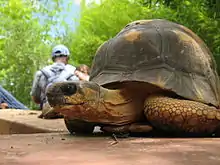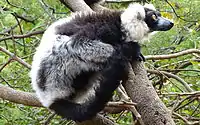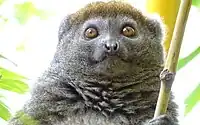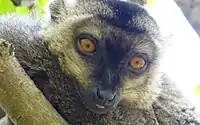| Lemurs' Park | |
|---|---|
 | |
| 18°57′8.65″S 47°21′27.13″E / 18.9524028°S 47.3575361°E | |
| Location | 22 km (14 mi) southwest of Antananarivo, Madagascar |
| Land area | 5 ha (12 acres) |
| No. of species |
|
| Website | www |
Lemurs' Park (also known locally as Parc de lémuriens à Madagascar) is a small botanical garden and lemur reserve covering 5 ha (12 acres), and is located 22 km (14 mi) southwest of Antananarivo, Madagascar. It was founded around 2000 by Laurent Amouric and Maxime Allorge. Most of its nine lemur species are free-ranging within the park, which also contains more than 70 of Madagascar's endemic plant species. The park is open to the public, offering guided tours as well as standard amenities, a gift shop, and a restaurant. Visitors can arrange transportation between downtown Antananarivo and Lemurs' Park on a private park shuttle.
Most of the park's lemurs were confiscated pets, entrusted to the park by the Ministry of Water and Forests. The lemurs are rehabilitated and bred for reintroduction into the wild. The park also collaborates with Colas Madagascar and TOTAL Madagascar to provide environmental education to local primary school children and to plant native trees as part of a reforestation program. Most of the park's staff come from the neighboring communities.
History
Established around 2000, Lemurs' Park is a private, 5 ha (12 acres) botanical park situated next to the Katsaoka River and between the villages of Fenoarivo and Imerintsiatosika, 22 km (14 mi) southwest of Antananarivo along Route Nationale 1 (RN1) in the direction of Ampefy.[1][2][3] It functions as a lemur reserve that gradually reintroduces captive-born lemurs back into nature.[1][3][4] The park was founded by Laurent Amouric and Maxime Allorge, the grandson of Pierre Boiteau, Founding Director of the Tsimbazaza Zoo (Parc Botanique et Zoologique de Tsimbazaza) in Antananarivo.[1]
Attractions


The park, which primarily consists of pine forest and bamboo vegetation,[1] contains nearly 6,000 trees and more than 70 plant species endemic to Madagascar,[3][5] all of which are segregated into separate climatic zones throughout the park.[2] Lemurs' Park also has a vivarium which houses chameleons, radiated tortoises, iguanas and other lizards.[1][5][6]
The main attraction, for which the park is named, is its free-ranging lemurs. Featured daily feeding times occur every two hours between 10:00 a.m. and 4:00 p.m.[2] There are nine species, seven of which are active during the day (diurnal) and two are active at night (nocturnal).[3][6] Many of the lemurs are confiscated pets, and the staff work towards rehabilitating them for reintroduction into the wild.[2]
| Common name | Scientific name | Conservation status | Images |
|---|---|---|---|
| Black-and-white ruffed lemur | Varecia variegata | Critically endangered[7] |
 |
| Common brown lemur | Eulemur fulvus | Near threatened[8] |
 |
| Coquerel's sifaka | Propithecus coquereli | Endangered[9] |
 |
| Crowned sifaka | Propithecus coronatus | Endangered[10] |
 |
| Eastern lesser bamboo lemur | Hapalemur griseus | Vulnerable[11] |
 |
| Mongoose lemur | Eulemur mongoz | Critically endangered[12] |
 |
| Ring-tailed lemur | Lemur catta | Endangered[13] |
 |
Conservation
Confiscated pet lemurs are entrusted to Lemurs' Park by the Ministry of Water and Forests (Ministère des eaux et Forêts) for ex situ conservation. This allows the urban population near Antananarivo to see free-ranging lemurs in a natural environment.[14] In addition to rehabilitation, Lemurs' Park has also successfully bred Coquerel's sifakas (Propithecus coquereli) since 2007.[1]
Because many of these lemurs have become endangered as a result of deforestation in Madagascar,[3] Lemurs' Park participates in a reforestation program supported by Colas Madagascar and Total Madagascar. Between December 2008 and May 2013, approximately 37,163 students and 1,270 teachers from the public primary schools around Antananarivo have helped plant 170 native trees and participated in environmental education at Lemurs' Park. For many of the children, this program has allowed them to see free-ranging lemurs for the first time. In total, more than 11,000 trees have been planted as part of this collaborative project, including rosewood, Terminalia, and amontana as of May 2013.[14][15] Saplings of endemic plants, including baobabs, from the Madagascar spiny thickets in the southern part of the island have also been transported to the park and planted with the help of Colas.[15]
According to the park, the partnership with Colas Madagascar and TOTAL Madagascar has also helped prevent layoffs of its staff during difficult economic times, over 90% of whom come from the surrounding communities.[14][15]
Business details
Lemurs' Park (Parc de lémuriens à Madagascar)[4] is open all year, seven days a week from 9:00 a.m. until 5:00 p.m.,[1][6] and the latest admission into the park is at 4:15 p.m.[6] As of March 2015, the admission price was 25,000 ariary for adults and 10,000 ariary for children ages 4–12, while admission for children under the age of 4 is free.[6] Entrance fees also cover a required tour with a park guide.[1][5] Stays are limited to 1 hour and 30 minutes.[6] The park provides standard amenities,[16] and has a restaurant that requires 48-hour advance booking. Between January and April, both the restaurant and gift shop are closed on Mondays.[1]
Visits to the park do not require advance booking, although reservations are required to take the park's minibus from the heart of Antananarivo (Analakely) to the facility. The cost of the shuttle includes the admission into the park.[1] The shuttle departs at 9:00 a.m. and 2:00 p.m. each day.[1][2]
Lemurs' Park also has a liaison office in Antananarivo that is only open on Monday.[17]
References
- 1 2 3 4 5 6 7 8 9 10 11 12 Mittermeier et al. 2010, pp. 671–672.
- 1 2 3 4 5 Bradt 2011, p. 166.
- 1 2 3 4 5 6 "Présentation du Lemurs Park" (in French). Lemurs' Park. 2013. Archived from the original on 24 September 2014. Retrieved 20 September 2014.
- 1 2 "Accueil" (in French). Lemurs' Park. 2013. Archived from the original on 24 September 2014. Retrieved 20 September 2014.
- 1 2 3 "Visite du park" (in French). Lemurs' Park. 2013. Archived from the original on 24 September 2014. Retrieved 20 September 2014.
- 1 2 3 4 5 6 "Tarifs année 2013" (in French). Lemurs' Park. 2013. Archived from the original on 24 September 2014. Retrieved 20 September 2014.
- ↑ Andriaholinirina, N.; Baden, A.; Blanco, M.; Chikhi, L.; Cooke, A.; Davies, N.; Dolch, R.; Donati, G.; Ganzhorn, J.; Golden, C.; Groeneveld, L.F.; Hapke, A.; Irwin, M.; Johnson, S.; Kappeler, P.; King, T.; Lewis, R.; Louis, E.E.; Markolf, M.; Mass, V. & Mittermeier, R.A., Nichols, R., Patel, E., Rabarivola, C.J., Raharivololona, B., Rajaobelina, S., Rakotoarisoa, G., Rakotomanga, B., Rakotonanahary, J., Rakotondrainibe, H., Rakotondratsimba, G., Rakotondratsimba, M., Rakotonirina, L., Ralainasolo, F.B., Ralison, J., Ramahaleo, T., Ranaivoarisoa, J.F., Randrianahaleo, S.I., Randrianambinina, B., Randrianarimanana, L., Randrianasolo, H., Randriatahina, G., Rasamimananana, H., Rasolofoharivelo, T., Rasoloharijaona, S., Ratelolahy, F., Ratsimbazafy, J., Ratsimbazafy, N., Razafindraibe, H., Razafindramanana, J., Rowe, N., Salmona, J., Seiler, M., Volampeno, S., Wright, P., Youssouf, J., Zaonarivelo, J., Zaramody, A. (2014). "Varecia variegata". IUCN Red List of Threatened Species. 2014: e.T22918A16121857. doi:10.2305/IUCN.UK.2014-1.RLTS.T22918A16121857.en.
{{cite journal}}: CS1 maint: multiple names: authors list (link) - ↑ Andriaholinirina, N.; Baden, A.; Blanco, M.; Chikhi, L.; Cooke, A.; Davies, N.; Dolch, R.; Donati, G.; Ganzhorn, J.; Golden, C.; Groeneveld, L.F.; Hapke, A.; Irwin, M.; Johnson, S.; Kappeler, P.; King, T.; Lewis, R.; Louis, E.E.; Markolf, M.; Mass, V. & Mittermeier, R.A., Nichols, R., Patel, E., Rabarivola, C.J., Raharivololona, B., Rajaobelina, S., Rakotoarisoa, G., Rakotomanga, B., Rakotonanahary, J., Rakotondrainibe, H., Rakotondratsimba, G., Rakotondratsimba, M., Rakotonirina, L., Ralainasolo, F.B., Ralison, J., Ramahaleo, T., Ranaivoarisoa, J.F., Randrianahaleo, S.I., Randrianambinina, B., Randrianarimanana, L., Randrianasolo, H., Randriatahina, G., Rasamimananana, H., Rasolofoharivelo, T., Rasoloharijaona, S., Ratelolahy, F., Ratsimbazafy, J., Ratsimbazafy, N., Razafindraibe, H., Razafindramanana, J., Rowe, N., Salmona, J., Seiler, M., Volampeno, S., Wright, P., Youssouf, J., Zaonarivelo, J., Zaramody, A. (2014). "Eulemur fulvus". IUCN Red List of Threatened Species. 2014: e.T8207A16117505. doi:10.2305/IUCN.UK.2014-1.RLTS.T8207A16117505.en.
{{cite journal}}: CS1 maint: multiple names: authors list (link) - ↑ Andriaholinirina, N.; Baden, A.; Blanco, M.; Chikhi, L.; Cooke, A.; Davies, N.; Dolch, R.; Donati, G.; Ganzhorn, J.; Golden, C.; Groeneveld, L.F.; Irwin, M.; Johnson, S.; Kappeler, P.; King, T.; Lewis, R.; Louis, E.E.; Markolf, M.; Mass, V.; Mittermeier, R.A. & Nichols, R., Patel, E., Rabarivola, C.J., Raharivololona, B., Rajaobelina, S., Rakotoarisoa, G., Rakotomanga, B., Rakotonanahary, J., Rakotondrainibe, H., Rakotondratsimba, G., Rakotondratsimba, M., Rakotonirina, L., Ralainasolo, F.B., Ralison, J., Ramahaleo, T., Ranaivoarisoa, J.F., Randrianahaleo, S.I., Randrianambinina, B., Randrianarimanana, L., Randrianasolo, H., Randriatahina, G., Rasamimananana, H., Rasolofoharivelo, T., Rasoloharijaona, S., Ratelolahy, F., Ratsimbazafy, J., Ratsimbazafy, N., Razafindraibe, H., Razafindramanana, J., Rowe, N., Salmona, J., Seiler, M., Volampeno, S., Wright, P., Youssouf, J., Zaonarivelo, J., Zaramody, A. (2014). "Propithecus coquereli". IUCN Red List of Threatened Species. 2014: e.T18355A16115770. doi:10.2305/IUCN.UK.2014-1.RLTS.T18355A16115770.en.
{{cite journal}}: CS1 maint: multiple names: authors list (link) - ↑ Andriaholinirina, N.; Baden, A.; Blanco, M.; Chikhi, L.; Cooke, A.; Davies, N.; Dolch, R.; Donati, G.; Ganzhorn, J.; Golden, C.; Groeneveld, L.F.; Irwin, M.; Johnson, S.; Kappeler, P.; King, T.; Lewis, R.; Louis, E.E.; Markolf, M.; Mass, V.; Mittermeier, R.A. & Nichols, R., Patel, E., Rabarivola, C.J., Rajaobelina, S., Rakotoarisoa, G., Rakotomanga, B., Rakotonanahary, J., Rakotondrainibe, H., Rakotondratsimba, G., Rakotondratsimba, M., Rakotonirina, L., Ralainasolo, F.B., Ralison, J., Ramahaleo, T., Ranaivoarisoa, J.F., Randrianahaleo, S.I., Randrianambinina, B., Randrianarimanana, L., Randrianasolo, H., Randriatahina, G., Rasamimananana, H., Rasolofoharivelo, T., Rasoloharijaona, S., Ratelolahy, F., Ratsimbazafy, J., Ratsimbazafy, N., Razafindraibe, H., Razafindramanana, J., Rowe, N., Salmona, J., Seiler, M., Volampeno, S., Wright, P., Youssouf, J., Zaonarivelo, J., Zaramody, A. (2014). "Propithecus coronatus". IUCN Red List of Threatened Species. 2014: e.T18356A16115921. doi:10.2305/IUCN.UK.2014-1.RLTS.T18356A16115921.en.
{{cite journal}}: CS1 maint: multiple names: authors list (link) - ↑ Andriaholinirina, N.; Baden, A.; Blanco, M.; Chikhi, L.; Cooke, A.; Davies, N.; Dolch, R.; Donati, G.; Ganzhorn, J.; Golden, C.; Groeneveld, L.F.; Hapke, A.; Irwin, M.; Johnson, S.; Kappeler, P.; King, T.; Lewis, R.; Louis, E.E.; Markolf, M.; Mass, V. & Mittermeier, R.A., Nichols, R., Patel, E., Rabarivola, C.J., Raharivololona, B., Rajaobelina, S., Rakotoarisoa, G., Rakotomanga, B., Rakotonanahary, J., Rakotondrainibe, H., Rakotondratsimba, G., Rakotondratsimba, M., Rakotonirina, L., Ralainasolo, F.B., Ralison, J., Ramahaleo, T., Ranaivoarisoa, J.F., Randrianahaleo, S.I., Randrianambinina, B., Randrianarimanana, L., Randrianasolo, H., Randriatahina, G., Rasamimananana, H., Rasolofoharivelo, T., Rasoloharijaona, S., Ratelolahy, F., Ratsimbazafy, J., Ratsimbazafy, N., Razafindraibe, H., Razafindramanana, J., Rowe, N., Salmona, J., Seiler, M., Volampeno, S., Wright, P., Youssouf, J., Zaonarivelo, J., Zaramody, A. (2014). "Hapalemur griseus". IUCN Red List of Threatened Species. 2014: e.T9673A16119642. doi:10.2305/IUCN.UK.2014-1.RLTS.T9673A16119642.en.
{{cite journal}}: CS1 maint: multiple names: authors list (link) - ↑ Andriaholinirina, N.; Baden, A.; Blanco, M.; Chikhi, L.; Cooke, A.; Davies, N.; Dolch, R.; Donati, G.; Ganzhorn, J.; Golden, C.; Groeneveld, L.F.; Hapke, A.; Irwin, M.; Johnson, S.; Kappeler, P.; King, T.; Lewis, R.; Louis, E.E.; Markolf, M.; Mass, V. & Mittermeier, R.A., Nichols, R., Patel, E., Rabarivola, C.J., Raharivololona, B., Rajaobelina, S., Rakotoarisoa, G., Rakotomanga, B., Rakotonanahary, J., Rakotondrainibe, H., Rakotondratsimba, G., Rakotondratsimba, M., Rakotonirina, L., Ralainasolo, F.B., Ralison, J., Ramahaleo, T., Ranaivoarisoa, J.F., Randrianahaleo, S.I., Randrianambinina, B., Randrianarimanana, L., Randrianasolo, H., Randriatahina, G., Rasamimananana, H., Rasolofoharivelo, T., Rasoloharijaona, S., Ratelolahy, F., Ratsimbazafy, J., Ratsimbazafy, N., Razafindraibe, H., Razafindramanana, J., Rowe, N., Salmona, J., Seiler, M., Volampeno, S., Wright, P., Youssouf, J., Zaonarivelo, J., Zaramody, A. (2014). "Eulemur mongoz". IUCN Red List of Threatened Species. 2014: e.T8202A16117799. doi:10.2305/IUCN.UK.2014-1.RLTS.T8202A16117799.en.
{{cite journal}}: CS1 maint: multiple names: authors list (link) - ↑ Andriaholinirina, N.; Baden, A.; Blanco, M.; Chikhi, L.; Cooke, A.; Davies, N.; Dolch, R.; Donati, G.; Ganzhorn, J.; Golden, C.; Groeneveld, L.F.; Hapke, A.; Irwin, M.; Johnson, S.; Kappeler, P.; King, T.; Lewis, R.; Louis, E.E.; Markolf, M.; Mass, V. & Mittermeier, R.A., Nichols, R., Patel, E., Rabarivola, C.J., Raharivololona, B., Rajaobelina, S., Rakotoarisoa, G., Rakotomanga, B., Rakotonanahary, J., Rakotondrainibe, H., Rakotondratsimba, G., Rakotondratsimba, M., Rakotonirina, L., Ralainasolo, F.B., Ralison, J., Ramahaleo, T., Ranaivoarisoa, J.F., Randrianahaleo, S.I., Randrianambinina, B., Randrianarimanana, L., Randrianasolo, H., Randriatahina, G., Rasamimananana, H., Rasolofoharivelo, T., Rasoloharijaona, S., Ratelolahy, F., Ratsimbazafy, J., Ratsimbazafy, N., Razafindraibe, H., Razafindramanana, J., Rowe, N., Salmona, J., Seiler, M., Volampeno, S., Wright, P., Youssouf, J., Zaonarivelo, J., Zaramody, A. (2014). "Lemur catta". IUCN Red List of Threatened Species. 2014: e.T11496A62260437. doi:10.2305/IUCN.UK.2014-2.RLTS.T11496A62260437.en.
{{cite journal}}: CS1 maint: multiple names: authors list (link) - 1 2 3 "Éducation environnementale" (in French). Lemurs' Park. 2013. Archived from the original on 24 September 2014. Retrieved 20 September 2014.
- 1 2 3 "Lemurs' Park". Colas Madagascar. 2011. Archived from the original on 27 February 2015. Retrieved 24 September 2014.
- ↑ "Infrastructures et services" (in French). Lemurs' Park. 2013. Archived from the original on 25 September 2014. Retrieved 20 September 2014.
- ↑ "Nous Contacter" (in French). Lemurs' Park. 2013. Archived from the original on 26 December 2014. Retrieved 20 September 2014.
Literature cited
- Bradt, Hilary (2011). Madagascar: the Bradt Travel Guide (10th ed.). Bradt Travel Guides Ltd. ISBN 978-1-84162-341-2.
- Mittermeier, R.A.; Louis, E.E.; Richardson, M.; Schwitzer, C.; et al. (2010). Lemurs of Madagascar. Illustrated by S.D. Nash (3rd ed.). Conservation International. ISBN 978-1-934151-23-5. OCLC 670545286.